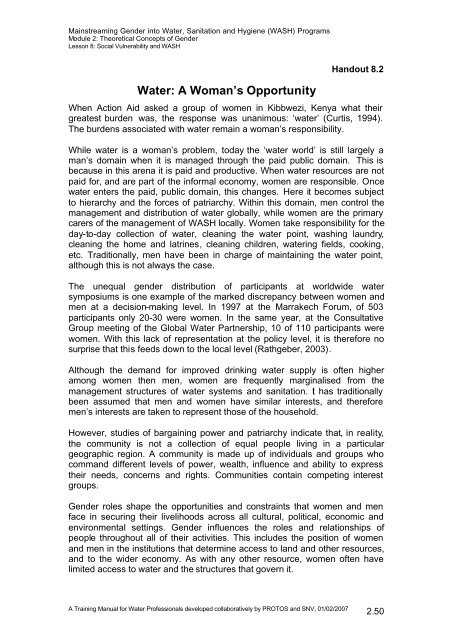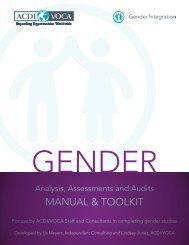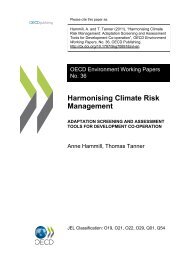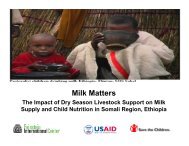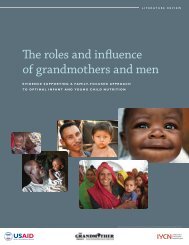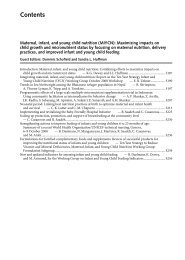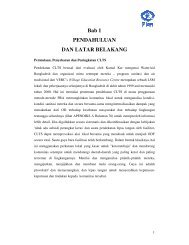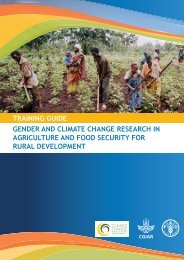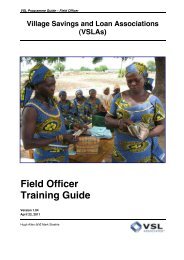Module 2. Theorethical Concepts of Gender - FSN Network Portal
Module 2. Theorethical Concepts of Gender - FSN Network Portal
Module 2. Theorethical Concepts of Gender - FSN Network Portal
You also want an ePaper? Increase the reach of your titles
YUMPU automatically turns print PDFs into web optimized ePapers that Google loves.
Mainstreaming <strong>Gender</strong> into Water, Sanitation and Hygiene (WASH) Programs<br />
<strong>Module</strong> 2: Theoretical <strong>Concepts</strong> <strong>of</strong> <strong>Gender</strong><br />
Lesson 8: Social Vulnerability and WASH<br />
Water: A Woman’s Opportunity<br />
Handout 8.2<br />
When Action Aid asked a group <strong>of</strong> women in Kibbwezi, Kenya what their<br />
greatest burden was, the response was unanimous: ‘water’ (Curtis, 1994).<br />
The burdens associated with water remain a woman’s responsibility.<br />
While water is a woman’s problem, today the ‘water world’ is still largely a<br />
man’s domain when it is managed through the paid public domain. This is<br />
because in this arena it is paid and productive. When water resources are not<br />
paid for, and are part <strong>of</strong> the informal economy, women are responsible. Once<br />
water enters the paid, public domain, this changes. Here it becomes subject<br />
to hierarchy and the forces <strong>of</strong> patriarchy. Within this domain, men control the<br />
management and distribution <strong>of</strong> water globally, while women are the primary<br />
carers <strong>of</strong> the management <strong>of</strong> WASH locally. Women take responsibility for the<br />
day-to-day collection <strong>of</strong> water, cleaning the water point, washing laundry,<br />
cleaning the home and latrines, cleaning children, watering fields, cooking,<br />
etc. Traditionally, men have been in charge <strong>of</strong> maintaining the water point,<br />
although this is not always the case.<br />
The unequal gender distribution <strong>of</strong> participants at worldwide water<br />
symposiums is one example <strong>of</strong> the marked discrepancy between women and<br />
men at a decision-making level. In 1997 at the Marrakech Forum, <strong>of</strong> 503<br />
participants only 20-30 were women. In the same year, at the Consultative<br />
Group meeting <strong>of</strong> the Global Water Partnership, 10 <strong>of</strong> 110 participants were<br />
women. With this lack <strong>of</strong> representation at the policy level, it is therefore no<br />
surprise that this feeds down to the local level (Rathgeber, 2003).<br />
Although the demand for improved drinking water supply is <strong>of</strong>ten higher<br />
among women then men, women are frequently marginalised from the<br />
management structures <strong>of</strong> water systems and sanitation. It has traditionally<br />
been assumed that men and women have similar interests, and therefore<br />
men’s interests are taken to represent those <strong>of</strong> the household.<br />
However, studies <strong>of</strong> bargaining power and patriarchy indicate that, in reality,<br />
the community is not a collection <strong>of</strong> equal people living in a particular<br />
geographic region. A community is made up <strong>of</strong> individuals and groups who<br />
command different levels <strong>of</strong> power, wealth, influence and ability to express<br />
their needs, concerns and rights. Communities contain competing interest<br />
groups.<br />
<strong>Gender</strong> roles shape the opportunities and constraints that women and men<br />
face in securing their livelihoods across all cultural, political, economic and<br />
environmental settings. <strong>Gender</strong> influences the roles and relationships <strong>of</strong><br />
people throughout all <strong>of</strong> their activities. This includes the position <strong>of</strong> women<br />
and men in the institutions that determine access to land and other resources,<br />
and to the wider economy. As with any other resource, women <strong>of</strong>ten have<br />
limited access to water and the structures that govern it.<br />
A Training Manual for Water Pr<strong>of</strong>essionals developed collaboratively by PROTOS and SNV, 01/02/2007<br />
<strong>2.</strong>50


